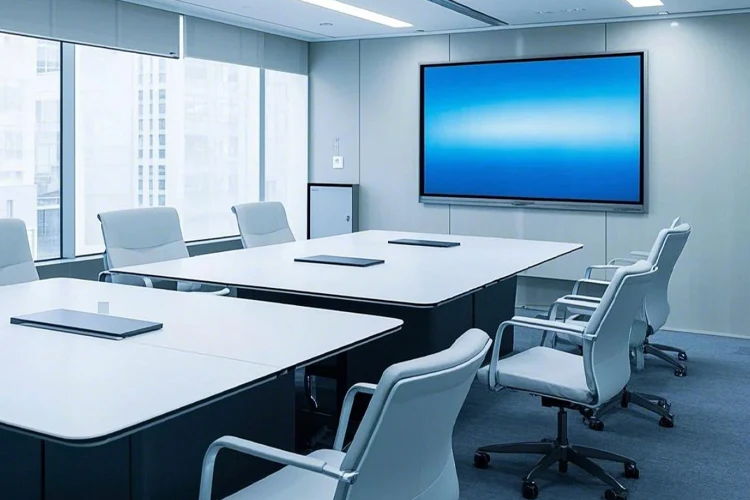With the advent of the intelligent era, people’s lives are constantly changing, and businesses are also gradually transforming. From traditional handwritten blackboards to multimedia devices, and then from multimedia to current LED displays, the changes are profound. Modern conference rooms are often equipped with display devices for conference displays, video conferencing, employee training, business receptions, and other purposes. Therefore, large LED screens play a vital role in various aspects of meetings. So how do you choose a high-definition, large-size LED display for your conference room?
1.What is the main purpose of an indoor conference room?
Different meeting scenarios have different requirements for LED displays, and the size of the conference room determines the size of the LED screen. For academic seminars and remote video conferencing, products with a resolution of 4K or higher to ensure that charts, data, and character details are clearly visible. The following are the main application scenarios for indoor conference room screens:
- Small conference rooms: First, conference rooms typically used for daily meetings, document presentations, small discussions, and presentations. They are smaller, typically seating 20 or fewer people. Second, people are typically relatively close to the screen, typically no more than 5 meters away, and the viewing distance is also short. Therefore, a screen width of 3-4 meters is sufficient for comfortable viewing; larger screens can be more glaring. Finally, these screens are easy to install, have low power consumption, and are cost-effective.
- Medium-sized conference rooms: Typically accommodate 20-50 people, with a viewing distance of 3 to 10 meters. Therefore, the screen size according to the background wall; typically, the screen width is approximately 2/3 to 3/4 of the background wall’s width. The mainstream aspect ratio for LED displays is 16:9, compatible with both HD (1920×1080) and 4K (3840×2160) resolutions. This allows for high-definition video conferencing, data presentations, and multimedia presentations.
- Large conference rooms/lecture halls: These can accommodate over 50 or even hundreds of people, requiring both detailed close-up viewing and long-distance visibility. Viewing distances are also very wide, ranging from 3-5 meters at close range to 15-20 meters or even further. Therefore, high brightness, high refresh rate, and stability are key requirements. A main screen + side screen combination can also be used to provide optimal viewing angles for everyone, making this a popular option for large-scale training sessions and presentations.
- High-end conference rooms are primarily used by executives and clients. Beyond basic refresh rates and brightness, these screens also demand exceptional image quality, overall aesthetics, seamless s, and vibrant color. Therefore, fine pitch, low noise, COB technology, and an ultra-thin design are key requirements.


2. How to choose the appropriate pixel pitch?
The pixel pitch is the distance between the centers of two adjacent LED pixels, in millimeters(mm). For example, P1.25, P1.53, P1.86, P2.5, etc. The general recommendation is:
- Small and medium-sized meeting rooms (viewing distance 3-10 meters): P1.53 – P1.86 is the current mainstream and cost-effective choice, with sufficient clarity.
- Large conference rooms/lecture halls (viewing distance 5-15 meters and above): P1.86 – P2.5 are common choices.
- High-end, close-range (<3 meters) conference rooms: COB with P1.25 or even smaller pitch can be considered, but the cost will increase significantly.
3. Installation and maintenance methods
First, fine-pitch LEDs (SMDs) are the absolute mainstream in current conference rooms. They utilize surface-mount technology, resulting in high pixel density and excellent display quality. Furthermore, COB/Micro LEDs are more advanced technologies, offering greater reliability, improved protection, and a wider viewing angle. However, they are more expensive and are suitable for ultra-high-end conference rooms with ample budgets. Finally, common installation options include wall-mounting and embedded systems. They support front maintenance, allowing for module replacement without disassembling the screen.
Currently, demand for LED displays in conference rooms is increasing. LED video walls offer convenience and speed in terms of application, pixel pitch, and installation. Furthermore, LED displays offer high resolution, high contrast, and high refresh rates, making them ideal for conference rooms.
